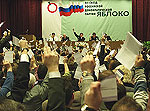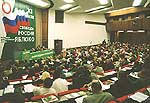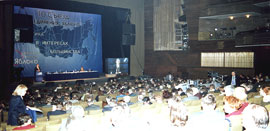The Pipe is No Longer Playing the Emperor’s Tune
The collapse came out of the blue, although it was visible from afar
Grigory Yavlinsky’s web-site, 21.04.2020
The economic crisis is growing. Despite Russia’s deal with OPEC, world oil prices continue falling. According to the terms of the deal, from May 1, Russia should reduce oil production to 8.5 million barrels per day. On average, the production of crude oil itself (without gas condensate) in Russia is about 10.4 million bps, that is, Russian oil companies have to reduce production by 1.9 million bps. This reduction is 6.5 times higher than the level of decline in production by Russia (0.3 million bpd), which the other parties to the deal insisted in early March and which the Russian negotiators refused. The new reduction is about 33% of Russian oil exports. Such a sharp rollback from the initial claims is due to a serious miscalculation of the assessment of the impact of the epidemic on the global economy and the global drop in demand, i.e., the “force majeure circumstances” – it is simply nowhere to store the excess volumes, and the reduction will have to be carried out by way of established fact.
As a result, the price of gasoline in the Russian wholesale market fell below cost: oil companies sell every ton with a loss of several thousand roubles.
Russia has problems not only with oil, but also with gas. For the entire first quarter, gas production in the country decreased by 6% on an annualised basis, and in March the collapse simply hit a record: 12.3% less gas was produced than in the same period last year. The reasons were: a warm winter, a decline in production caused by quarantine, and US supplies of liquefied natural gas. European gas storages are full, and Russian gas is sold in Europe today at a price of USD 80 per 1,000 cubic meters, which is a about 30% less than at the beginning of the year. To compensate for the loss of Gazprom due to falling gas prices on the international market, the Russian government decided to increase the gas tariff for Russians from July 1: by 3% for the population and by 2.99% for other categories of consumers. The increase in gas tariffs in the midst of an epidemic and crisis, as well as the sale of gas at a loss to producers, indicate, firstly, the inadequacy of decisions made in the government, and secondly, the depravity and exhaustion of the economic model based solely on the fuel and energy sector .
Over the past twenty years, despite all the talk, government lamentations and presidential statements, Russia’s dependence on commodity exports and world prices has not only fail to decrease, but even increased. Even according to the Federal State Statistics Service, the share of extraction of mineral resources in Russia grew from 34.1% in 2010 to 38.9% in 2018, and the share of manufacturing industries, on the contrary, shrank. All these years, the Russian authorities have behaved like a drug addict who has a pipe with gas in one hand, oil in the other, and economic hallucinations in his head. It is because of these “hallucinations” that strategic miscalculations were made when making key decisions. And in the end, Russia remained with the “pipe economy”.
Already in the foreseeable future, oil can no longer serve as the main source of Russia’s welfare. In the short term, this is due to falling oil demand and overstocking. Thus, on April 20, by the end of exchange trading, sellers began to pay USD 40 per barrel to buyers of American WTI oil (due to a collapse in prices by more than 300% – to minus USD 39.44 per barrel). The price of Russian Urals oil also became negative and amounted to minus USD 2 per barrel, which is 112.7% less than the previous price of USD 15.75. It is obvious that a 10 million bpd reduction in production, which Russia and OPEC allegedly managed to agree on, will not eliminate the existing surplus and will not solve the problem of price collapse.
The next two to three months will show whether the cartel agreement is able to keep prices in the region of at least USD 20 per barrel. In the meantime, it is obvious that the previous volumes of oil will not be in demand for a long time (against the backdrop of the global economic downturn and the problems of the Chinese economy), and by the time they are needed, there will be a lot of cheap Saudi oil on the market, solar panels, wind generators, and other “green” energy sources.
After the pandemic is over, the economy will recover and the price of oil will start rising slightly. At this point, many manufacturers will have incentives to quickly increase production and sales in order to somehow compensate for their losses during the recession. In this situation, it is highly likely that the OPEC+ cartel, if it is preserved by that time, will go out of control, and this, in turn, will be a deterrent to price increases. So even in the medium term, one should not count on a rapid rise in oil prices. This may last for years, as happened after the collapse of the oil cartel in the early 1980s.
We should not forget about the geopolitical vulnerability of Russia. The United States, for example, can easily push Russia out of the world market if they wish, by imposing an embargo on Russian oil exports, as they did with Venezuela. Recently, Washington has accused the Venezuelan President and fourteen of his associates in drug trafficking and began to transfer military equipment to the borders of Venezuela. President Maduro faces life imprisonment for participation in drug trafficking. Having sensed that the odds are against them, Rosneft got rid of all its Venezuelan assets by “selling” them to the Russian state, and now all the Russian oil extracting industry may fall under American sanctions.
In addition, there are other, more significant circumstances that will impede the growth of prices for “black gold”. Thus, oil (after coal) will be increasingly going by the wayside. A “three-level market” of oil will be gradually formed: 1) Saudi Arabia; 2) global companies, including Russian; 3) non-standard manufacturers, whose marginal costs will act as a price limit. Such a structure is self-regulating and theoretically can be effective. It does not require “manual control,” and if someone (as the “great strategists” from Russia recently) decides to radically change it with the help of a price war, such an attempt would be doomed to failure from the very beginning. In the long run, an attempt to raise prices above the limit level will not lead anywhere either, since “non-standard producers” which are final in this three-tier structure and necessary for satisfaction of the demand will lose profitability above this level. And taking into account the development of alternative energy, this marginal level will continue to decline.
Nobody knows the speed of this process, but the meaning of politics is to understand the patterns and market logic of the upcoming developments and make decisions in accordance with this. In the next ten years, the efficiency of the Russian oil sector will be steadily declining due to the increasing complexity of production conditions, the remoteness of the location of reserves, growing costs, and also due to falling demand for oil. This will require fundamental changes in the concept of the entire budget and financial system of Russia – a rejection of the decisive dependence of the budget on the exports of natural resources. The key requirement is as follows: true diversification of the Russian economy and creation of a modern competitive system to replace the current state capitalist system. This is possible only if one abandons the [economic] model based on raw materials and the corporate mafia political system. Without this, Russia has no prospects for successful and peaceful development in the 21st century.
See also:
“What will happen to the economy and why did the oil price fall?” published on 15.03.2020
Is Chairman of the Federal Political Committee of the Russian United Democratic Party YABLOKO, Vice President of Liberal International, PhD in Economics, Professor of the National Research University Higher School of Economics.
Posted: April 22nd, 2020 under Economy, Russian Economy.







